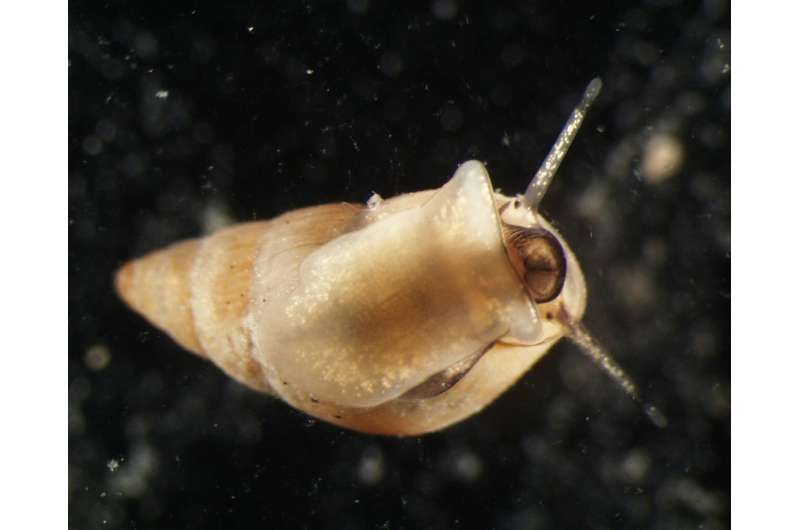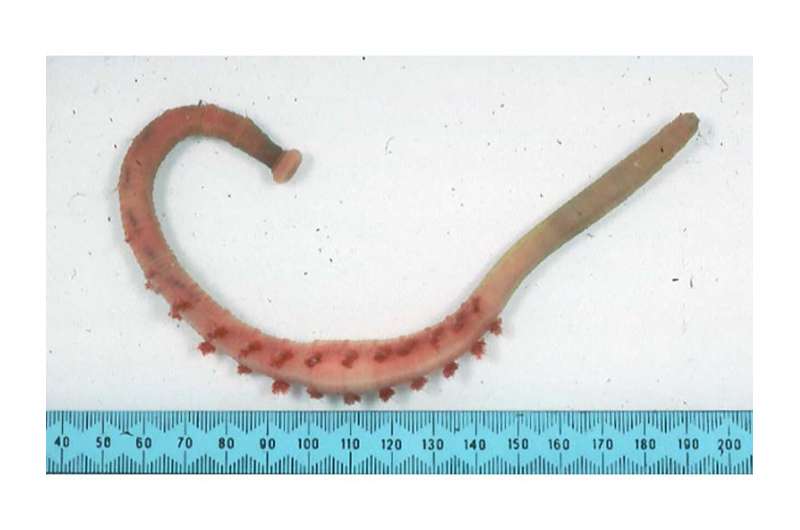Decline in nutrient load and sea-level rise: Winners and losers in the Wadden Sea

A team of researchers, including Senckenberg scientists Prof. Dr. Ingrid Kröncke and Dr. Anja Singer, has detected a significant decrease in the abundance, biomass, and spatial distribution of characteristic benthic species such as snails, mussels, crabs, or worms, in the East-Frisian Wadden Sea.
The team compared an extensive, current dataset from 2018 from about 500 monitoring stations with a comparable, historical dataset from the 1980s. In their study, published in the journal Frontiers in Marine Science, the researchers attribute the change in species composition in the East-Frisian Wadden Sea to a reduced nutrient load and the effects of a rising sea level on the benthic communities in the tidal flats.
“The populations of the Laver spire shell Peringia ulvae, which still dominated in the 1980s, the sand mason worm Lanice conchilega, or the sand gaper Mya arenaria have decreased by more than 80%,” explains first author Dr. Anja Singer of Senckenberg am Meer and Carl von Ossietzky University in Oldenburg, and she continues, “We investigated the species composition and changes in the East-Frisian Wadden Sea in a large-scale, long-term study and a clear change was detected in the abundance, biomass, and spatial distribution of numerous characteristic species.”
In their study, the research team shows that although the total number of species found in the study area has remained almost constant since the 1980s, the quantitative and spatial distribution as well as the biomass of many species has changed significantly. In the 1980s, there was a total of 90 species; in 2018, 81 species were recorded.
“Much more significant is the decrease in the total number of individuals within many species per square meter. Here, we found an average decline of about 31%. The total biomass even decreased by approximately 45%, compared to the 1980s,” explains Prof. Ingrid Kröncke from Senckenberg am Meer and the University of Oldenburg. The biomass of three species that were predominant in the 1980s—the Laver spire shell Peringia ulvae, the sand mason worm Lanice conchilega, and the European mud scud Corophium volutator—declined by more than 80%.
In particular, animals such as the Laver spire shell Peringia ulvae or various clam species that feed on small algae growing on the sediment surface show a sharp decline in the researchers’ analyses, which is also reflected in these species’ total biomass and overall frequency. The decline is presumably due to a reduced food supply.
“Since the 1980s, stricter requirements have been legally adopted for agriculture and municipal sewage treatment plants, resulting in fewer nutrients entering rivers such as the Elbe, the Weser, or the Rhine—and thus our study area as well. This reduced nutrient load leads to a significant decrease in algal blooms—the main food source of the aforementioned animals,” explains Kröncke.
“However, what may be disadvantageous for the Laver spire shell is clearly beneficial for other organisms. The improved water quality, for example, has a positive effect on seagrass bedsand mixed mussel/oyster reefs, for example. The results of our study confirm that seagrass beds in the German Wadden Sea recovered by 2018, and mixed mussel/oyster reefs expanded.”

The biomass of the lugworm Arenicola marina also increased by about 75%. “We explain this increase with higher sand accretion rates on the tidal flats due to sea level rise, especially in the western part of the East-Frisian Wadden Sea. In addition, higher current velocities caused by the sea level rise simultaneously led to a decrease in mud content in the sediments. A synergy of these two processes, sand accumulation and decrease in mud content, provide better habiat conditions for the lugworm and other species,” says Singer.
The total number of invasive species increased from two to a total of six species, according to the new study. The climate-induced increase of about 2°C in sea surface temperatures since the 1980s in the study area favors the establishment of new invasive species, the researchers said. The Atlantic jackknife clam (Ensis leei) is now found about 80% more frequently in the East-Frisian Wadden Sea.
The invasive clam is one of the “winners” in this part of the Wadden Sea UNESCO World Heritage Site. The four invasive species newly recorded in 2018—the common slipper limpet Crepidula fornicata, the Pacific oyster Magellana gigas, the dwarf surf clam Mulinea lateralis, and the predatory shore crab Hemigrapsus spec.—are all considered tolerant of higher temperatures.
“Our results show obvious changes in the benthic communities in the tidal flats that will have a significant impact on the overall food web in the Wadden Sea. Bottom-dwelling species in the tidal flats provide an important food source for juvenile flatfish and breeding and resting bird species. As the sea level and temperatures continue to rise, the Wadden Sea ecosystem will face serious ecological and biological changes in the future.
“Therefore, detailed knowledge of the changes in the Wadden Sea UNESCO World Heritage Site is crucial for environmental decision-making and the development of realistic management concepts with the overall goal of creating a permanent strategy for sustainable use of the natural marine resources,” states Singer.
More information:
Anja Singer et al, Long-term response of coastal macrofauna communities to de-eutrophication and sea level rise mediated habitat changes (1980s versus 2018), Frontiers in Marine Science (2023). DOI: 10.3389/fmars.2022.963325
Citation:
Decline in nutrient load and sea-level rise: Winners and losers in the Wadden Sea (2023, March 7)
retrieved 7 March 2023
from https://phys.org/news/2023-03-decline-nutrient-sea-level-winners-losers.html
This document is subject to copyright. Apart from any fair dealing for the purpose of private study or research, no
part may be reproduced without the written permission. The content is provided for information purposes only.
For all the latest Science News Click Here
For the latest news and updates, follow us on Google News.

